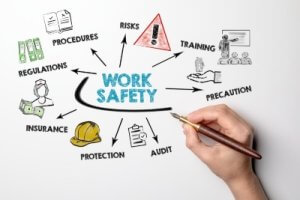By Sarah Laybolt
What is “Safety Culture,” Plus Why is it Important?
Culture is a word that we probably all have heard and at least have an idea what it means but do we understand how it applies to the workplace and, in particular, to health and safety in the workplace?
We refer to this as “safety culture,” It is an extremely important aspect of keeping workers safe. Across the board, different companies have different stances and invest different time and money into health and safety; some only the bare minimum while others go above and beyond. However, investing in health and safety and having a strong safety culture within the workplace is a proven priority that prevents accidents and ultimately saves lives.

Safety culture can be defined in many different ways, but the best definition I found was from the Canada Energy Regulator (click the link to read more). They say that Safety Culture is “the everyday attitudes, values, norms, and beliefs that leaders and staff share about risk and safety. What leaders and staff see, hear, feel, and say affects decision-making and behaviour. These decisions and behaviours, if positive toward protecting people and the environment, can contribute to preventing major accidents.”
Communication
Communication is again something that a lot of us hear about being important. Yet, it is a skill that many of us have never properly developed or practice in our lifetimes, at least not how to effectively communicate. A big influencer on this in the workplace sometimes comes down to fear of getting in trouble or repercussions for specific actions.
You can only prevent those you know to exist when it comes to hazards and risks. But, until you know they exist, how can you do anything about them? This is why there is so much emphasis on creating a safety culture where employees feel comfortable coming forward, discussing their concerns and then taking action, regardless if it was a mistake on their end that led to exposing the hazard in the first place.
Having clear and concise policies and procedures in place, is the first step in effectively communicating the expectations, to employees in order to keep everyone safe. Delivering these policies and procedures, though, making everyone clearly aware of known hazards, and the organization’s efforts to continuously be assessing for new ones is essential in getting everyone on board. Without the knowledge, they simply just don’t know, and therefore this needs to begin at onboarding a new employee and be refreshed every so often, or any time there is a change. In addition, these policies and procedures need to be kept up-to-date, relevant to your organization, and easily accessible for everyone.
Next, these policies and procedures need to be encouraged and followed by all levels of the organization, from the top-down. Employees are only going to be on board and willing to follow what is in place to protect them if they see all levels of the organization doing the same – consistency is key.
Tip: Hold regular safety talks, either incorporated into a meeting or on their own. Make them fun and informative on a topic that is relevant to your organization. Also, keep your employees engaged and encourage employee involvement; which leads us to our next point.
Employee Involvement
Closely related to communication is employee involvement. People want to be heard and have a say; we are human, after all. We also want to know that people care. When employees feel safe and empowered, they are more likely to get involved. Therefore, it is essential to connect directly with your employees to discuss health and safety as an organization. If employees feel and know that you care about them and their safety at work through the communications and actions they see, they are more apt to comply and get involved in keeping everyone else safe.

When an employee makes a safe decision or a good decision, let’s say it is essential that employers are giving praise and empowering this behaviour. In doing this, you encourage them to continue working in this manner, and also demonstrate to others that the organization really does place value on keeping everyone safe.
All in all, employees need to feel protected and heard. But, when it comes to health and safety, they need to be involved and empowered.
Lead by Example
Leading by example is one of the foundations of being an effective leader. Leading by example is what gains you the respect of your employees and the others around you and demonstrates that you truly do care and value the measures put in place to keep everyone safe within the organization.
Effective leadership is key in establishing and maintaining a positive and strong safety culture.
Leaders must purposefully demonstrate that the prevention of injury and accidents is of high priority and value, or else they will lose the buy in from their team, and the health safety culture will slowly diminish. Top-down management is very important in getting everyone on board and ready to work safely.
Another aspect of leading by example is remembering that as a leader, you must have the right attitude to coach staff and help encourage good behaviours to be maintained.
Access to Training
Up until this point, we have talked about the importance of proper, clear, purposeful communication, how it is important to involve employees in health and safety at the workplace, the benefits as to why and the need to lead by example from the top, down. However, simply creating a positive attitude surrounding safety culture and health and safety in your workplace is not enough to keep everyone safe.
Workers need to be equipped with the knowledge and information that they receive through formal training courses, too, sometimes even above and beyond the bare minimum requirements set out. As an organization, you need to be aware and continuously learn from your own and others’ experiences.
I am sure we can all agree that the idea of training is usually not a positive one and definitely not something people necessarily get excited about. I mean, we probably all have had to endure at one point or another a dry, low interactive safety training course where we could not wait for it to be over, we don’t fully retain what we went there to learn in the first place, ‘making it a complete waste of time and money’.

This is why it is important to research who you invest your dollars in and to find a training provider who is going to engage your employees and hold their interest throughout the course. That’s why we at Industrial Safety Trainers we pride ourselves on the fact that we offer an interactive, discussion-based learning method that
changes the way workers look at safety in the workplace because workers receive the important information they require in a setting that doesn’t make them want to fall asleep, they are engaged and involved. Providing access to this training and investing in your employees only further demonstrates your commitment as an organization to keeping people safe and this, in turn, strengthens that safety culture even more.
In the end, it all comes down to organizations being proactive in their health and safety efforts. It means keeping policies and procedures relevant and up-to-date. It takes fostering and maintaining a healthy safety culture where everyone is on the same page. Organizations need to start changing the perspective on the importance of investing in health and safety.
Establishing or changing a safety culture can have its challenges, and it also can be time-consuming, but it will always be worth it. So, starting today, one step at a time, begin considering your safety culture and assessing where your organization is at. Health and safety truly is a fundamental component to doing business successfully, and remember, it is always better to be safe than sorry.
Our vision at Industrial Safety Trainers is that we believe the goal of making a workplace safe should not be a burden to the employer; rather, it should be easy and affordable.
Courses to Consider
Joint Health and Safety Committee Certification
Health, Safety and the Law (Health and Safety Reps and Supervisors)
Accident Investigation Training
Consulting Programs / Opportunities
Job Site Safety Inspections and Report Writing
Reasonable Suspicion Training
Training on Material Handling Equipment
Workplace Hazard Recognition Training
Violence and Harassment Programs
Visit www.thesafetybus.com or email us at [email protected] for a full listing of courses and consulting services we offer, including our no-cost visit option.






